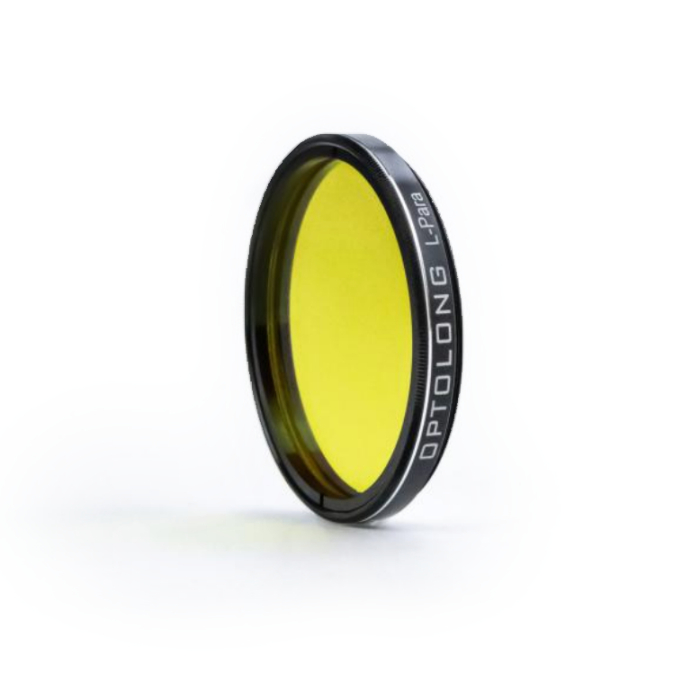Optolong L-Para 2" Dual Band Filter
Conquer Light Pollution with this Optolong L-Para Filter!
For those who live in urban settings, light pollution is a difficult challenge to overcome. Light from sodium, mercury, and LED lamps wash out the night sky, making it hard to discern detail on celestial bodies. Helping you cut through the murk, this Optolong L-Para is a must have within your imaging toolkit! With a 10 nm bandwidth in the Ha and OIII wavelengths, enjoy capturing rich detail on nebulae from within the city, highlighting beautiful structure and stunning colors that would have otherwise been shrouded by light pollution.
As a dual-band filter, the L-Para is designed to be paired with color cameras, producing full-color astroimages in just one shot. Ideal for use on emission nebulae, such as the Soul Nebula, the Veil Nebula, and plenty more, this filter presents stark contrast on nebulosity and the background sky. It is crafted with the utmost precision, delivering 85% transmission rates for focal ratios f/2 and above. Additionally, you can expect halo-free stars thanks to its careful design. Housed within a threaded filter cell and adaptable to fast optics like RASA and HyperStar, this Optolong L-Para is compatible with just about any imaging system!
A High Performance Astrophotography Filter of the Utmost Quality
Let's Take a Deeper Look!
What sets one filter apart from another? Which filter is best for me? When developing a filter, manufacturers provide a chart that represents the wavelengths permitted through this filter. This gives insight into the filter’s performance, and what it can help you achieve. So, how exactly do I read a transmission chart? Our team has put together a comprehensive article, to help you understand the fundamentals on How to Read a Transmission Chart. Check out the article and feel more confident about choosing the right filter for your needs!
More Detail, Less Light Pollution
Opening the doors to capturing outstanding images from the city, this L-Para is a perfect solution for those surrounded by light pollution. Read more below as we highlight the key features that make this filter a must have, showcasing its applications, versatility, and optical integrity.
Exquisite Detail on Emission Nebulae
H-alpha (656.3 nm) and OIII (500.7 nm) are two of the most abundant emission lines within emission nebulae. As opposed to collecting these wavelengths individually with two different filters and a monochrome camera, this L-Para collects Ha and OIII in one go, bringing narrowband imaging to your color camera. Not only can you create full color images in less time, but your imaging sessions will be more streamlined with only one filter to manage. With a narrow bandwidth of 10 nm, this Optolong L-Para ensures each emission is well defined within the captured frames. A bandwidth this slim effectively blocks out light from surrounding street lamps and homes, making it wonderful for environments up to Bortle class 7.
Effortless Integration
This Optolong L-Para is housed within a metal filter cell and features M48x0.75 threads, allowing it to easily incorporate into just about any setup! Either thread it into a filter wheel, a filter drawer, or through a direct connection within your imaging train. The 2” diameter provides even illumination even across full frame sensors, ensuring outstanding performance from corner to corner.
Built With Quality in Mind
Designed to deliver both quality and durability, Optolong has crafted this filter with the utmost precision. The 1.85 mm thick optical glass offers impressive light transmission at the Ha and OIII wavelengths, providing clear detail and exceptional contrast. With this L-Para, even bright stars within your images will be sharp and halo-free, a result of the extensive optimization testing performed by Optolong. The slender filter cell integrates seamlessly into the majority of filter housings on the market today, while also offering incredible security with its metal build!
Astronomy Hub: Your one-stop-shop for Astrophotography Knowledge!
Our Gear Experts have compiled a wealth of information to help expand your astrophotography knowledge! Below you’ll find links to articles, videos and "how-to" guides. Just one more reason that our Astronomy Hub is a one-stop-shop for all your astronomy and astrophotography needs!
| The Effects of Light Pollution |
| 10 Things You Need to Know About Nebulae |
| Choosing the Best Deep Sky Camera |








